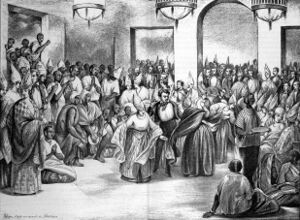Signare
Topic: Social
 From HandWiki - Reading time: 4 min
From HandWiki - Reading time: 4 min
Signare was the name for the Mulatto French-African women of the island of Gorée in French Senegal during the 18th and 19th centuries. These women of color managed to gain some individual assets, status, and power in the hierarchies of the Atlantic Slave Trade.[1]
Social and economic role
Signares commonly had power in networks of trade and wealth within the limitations of slavery. The influence held by these women led to changes in gender roles in the family structure archetype. Some owned masses of land as well as slaves. European merchants and traders, especially the French and British, would settle on coastal societies inhabited by signares in order to benefit from the increased proximity to the sources of African commerce. The earliest of these merchants were the Portuguese. These merchants were given the name "lançados", because "they threw themselves" among Africans, and they would establish relationships with the most influential signares who would accept them in order to obtain commercial privileges.[2]
Many signares were wed under “common local law” that was recognized by priests of the Catholic faith. These marriages were for economic and social reasons. Both signares and their husbands gained from these partnerships. Europeans passed their names down to the offspring and with it their lineage.
When some of the signares became too powerful, leaders like the Portuguese Crown sought ways to remove the women from their wealth. Different crimes that the Portuguese Crown sought to accuse the women of were crimes against the state or crimes against Christianity. An example of this appears with Bibiana Vuz de França. She was a prominent signare who over the years accumulated a lot of wealth and slaves. After realizing how powerful that she was, the Crown wanted to find a way dismantle her influence and power. “Accused of rebellion, trading with foreigners, and tax evasion, she was imprisoned with her younger brother and another co-conspirator and taken to Cape Verde Islands”.[3]
She was able to receive a royal pardon and free her younger brother after leading a coup against the Crown’s representatives. Due to her power, the Crown sought to criminalize Bibiana Vuz de França. However, once they realized that she was too powerful and too influential, all charges against her were dropped and she was once more considered loyal to the crown. Bibiana Vuz de França’s confrontation with the Portuguese Crown represents the strength that the signares in this time period had, and also the Portuguese growing inability to control the people.
Social mobility
The social status of signares also allowed for greater social mobility in Gorée than in other parts of Africa. Though there is limited documentation on the origins of most of the signares, it seems likely that at this time the people of Gorée were divided into several social classes: the jambor or freeborn; the jam or people of slave descent; the tega and uga or blacksmiths and leatherworkers and griots or storytellers.
Many signares were of the jam or griot class, and were often married by European men because they were considered especially beautiful. Once married to European men, women helped them handle many of their trading affairs and transactions, and gained economic and social stature in the community themselves. In this way women of lower social status could gain power in the community and become important traders through their marital status.
Marital practices
Marriages between African women and European men were governed by local law. Given the fact that many European men would not stay in Gorée permanently, marriages were often in a state of flux. If a European man left Gorée and intended to return, the African woman would wait for him. When the man got on the boat to go back to Europe, signares would scoop up the sand where his last footprints were and put it a handkerchief, which she'd hang on her bedpost it until he returned. Signares would often wait years for men to return without remarrying.
If European men left without planning to return, or if a signare learned that her European husband was not going to return to Gorée, women would remarry. This was not considered shameful in any way, and signares would not lose any of their social status, and would often retain much of the trading power that they gained through their prior marital status. Remarried signares would often raise their children from their European husbands alongside their new African husbands, and these children would receive inheritance from their mothers, not their fathers.
List of notable signares
- Victoria Albis
- Hélène Aussenac
- Anna Colas Pépin
- Anne Pépin
- Mary de Saint Jean
- Crispina Peres
See also
- Gens de couleur
- Affranchi
- Plaçage
- French people in Senegal
- Morganatic marriage
- Concubinage
- Hypergamy
- Marriage à la façon du pays
Sources
- George E. Brooks, Eurafricans in Western Africa: Commerce, Social Status, Gender, and Religious Observance from the Sixteenth to the Eighteenth Century (Ohio University Press, 2003).
References
- ↑ Brooks, George (1976). The Signares of St. Louis and Gorée: Women Entrepreneurs in Eighteenth-Century Senegal. pp. 19–44.
- ↑ Hafkin, Nancy J., and Edna G. Bay. Women in Africa: Studies in Social and Economic Change. Stanford, CA: Stanford UP, 1976. Print.
- ↑ Havik, Philip J.. Women and trade in the Guinea Bissau region: the role of African and Luso-African women in trade networks from the early 16th to the mid 19th century.2012. Print.
 KSF
KSF

